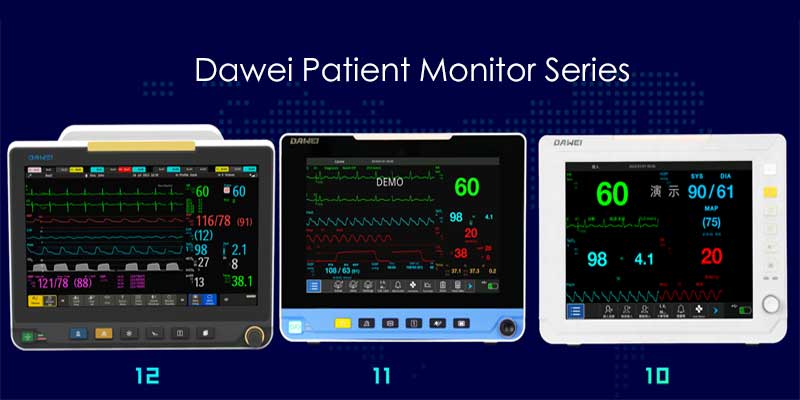With the close connection between human beings and animals, animals play an important role in human life, not only as companions and friends of human beings, but also as important resources in agriculture, scientific research, entertainment and other fields. So in order to better protect animals, improve animal vitality and be able to detect animal vital signs information in real time, animal vital signs monitor is very necessary no matter in surgery, post-surgery, or trauma care, etc. Animal vital signs monitor equipment is mainly a veterinary patient monitor.
Veterinary patient monitor is a device to measure and control the physiological parameters of the animal, and can be compared with the known set value, if there is an exceeding of the standard can issue an alarm. Based on the monitoring of animal life information, animal monitors are used in a wide range of scenarios: operating theatres, ICUs, research institutes, etc., especially in pet hospitals are widely used.
1、Real-time health monitoring
The veterinary patient monitor can be used to monitor the physiological parameters of animals, blood oxygen, blood pressure, body temperature, ECG, respiratory rate, heart rate, CO2, IBP (more for scientific research), and it is very necessary to detect the vital signs of animals during and after surgery.
Monitoring an animal’s heart rate (PR, ECG) during and after surgery helps to assess the function and stability of its cardiovascular system and ensures that the heart is functioning properly during surgery. Monitor the animal’s respiratory rate (RESP) to help confirm that the animal is breathing steadily and prevent apnoea or abnormalities. Monitor the animal’s blood oxygen level (SpO2) to find out how much oxygen is in its blood and to make sure its respiratory system is good. Monitor the animal’s blood pressure level (NIBP) to assess the condition of its circulatory system and to detect and treat possible blood pressure abnormalities in a timely manner. Monitoring the animal’s body temperature (TEMP) helps to maintain the body temperature within the normal range and prevent problems caused by hypothermia or hyperthermia. Animal surgery usually requires the use of anaesthetics, monitoring the depth of anaesthesia helps to ensure that the animal does not wake up or go into too deep anaesthesia during surgery, and monitoring the CO2 in the animal’s exhaled breath helps to assess its respiratory function and anaesthesia effect. This monitoring information can be displayed in real time on the monitor’s screen, allowing healthcare professionals to keep abreast of the animal’s physiological status and make timely adjustments and interventions. By using the animal monitor, the veterinary surgical team can perform the surgery more safely, reduce the surgical risk and improve the success rate of the surgery.
2、Diagnosis and treatment
When diagnosing animals, the use of animal monitors can continuously and dynamically detect animal blood oxygen, blood pressure, body temperature, ECG, respiratory rate, heart rate, CO2, etc., and this information is crucial to the diagnosis and treatment process. By comparing the changes in physiological parameters before and after treatment, it is possible to understand whether the treatment is effective or not, and whether it is necessary to make adjustments or replace the treatment plan.
3、Research and Scientific Exploration
The animal vital signs monitor is a very useful tool in research fields such as animal behaviour and ecology. In addition to recording the previously mentioned parameters such as blood oxygen, blood pressure, heart rate, etc., animal monitors also have IBP detection. Researchers can use the data from the monitor to conduct experiments and studies to gain insight into animal physiology and pathophysiology. At the same time, the monitors are also used for training and teaching to help develop professional veterinarians and healthcare professionals.
The necessity of animal vital monitors in diagnosis and treatment, especially in surgical procedures, cannot be ignored. Therefore, animal vital signs testing provides real-time monitoring of physiological parameters for healthcare professionals, which helps to detect problems early, assess the effectiveness of treatment, and ensure the safety of treatment, as well as providing an important tool and data source for scientific research and teaching. Through the use of animal monitors, the accuracy and success rate of diagnosis and treatment can be improved, providing better protection for the health and well-being of animals.
Post time: Jul-25-2023




